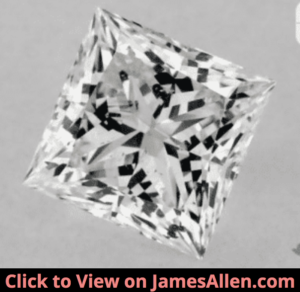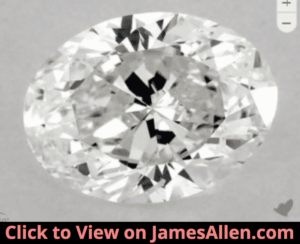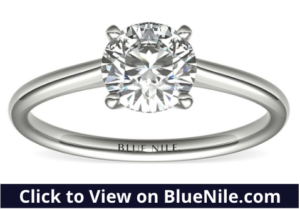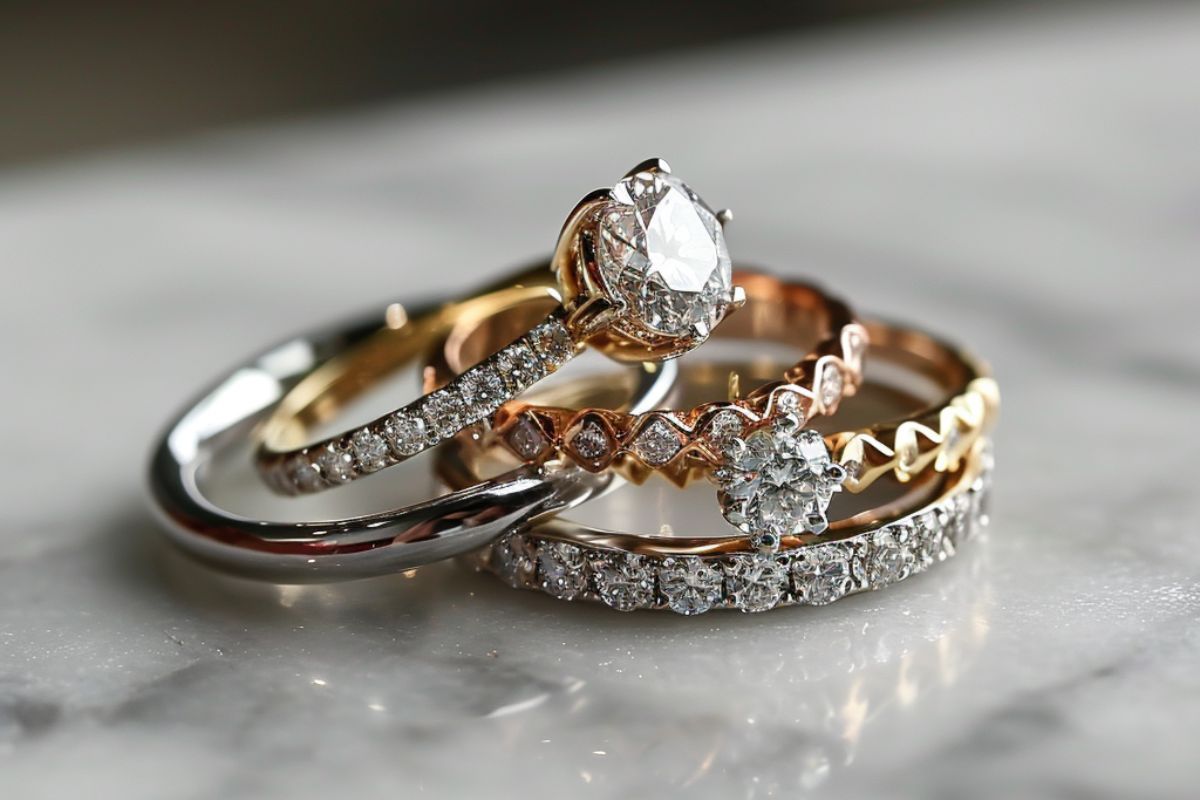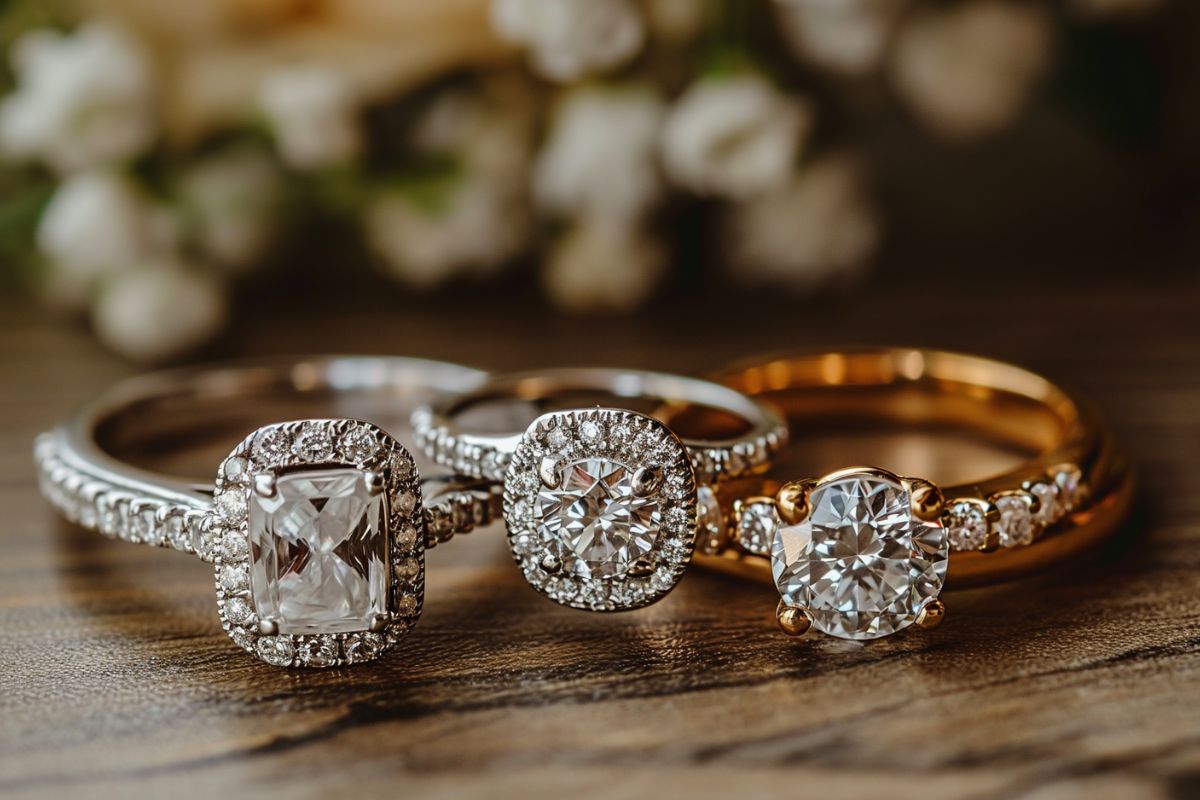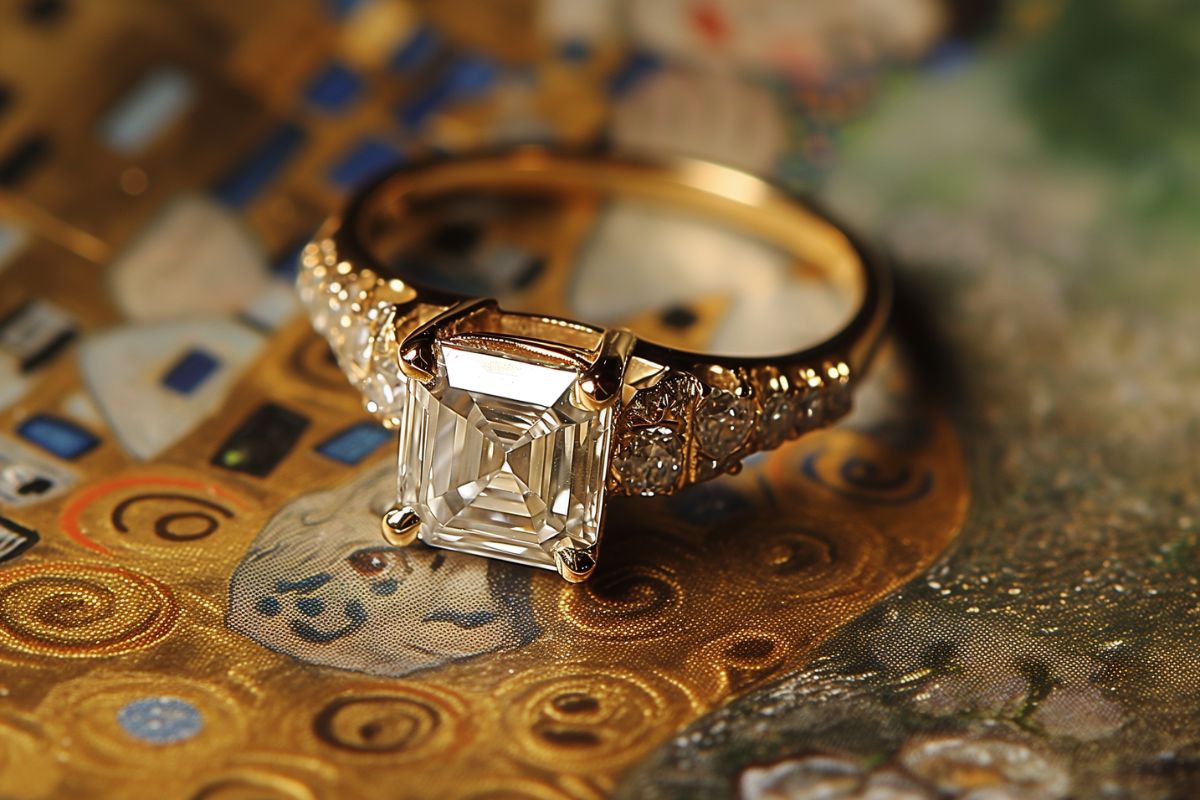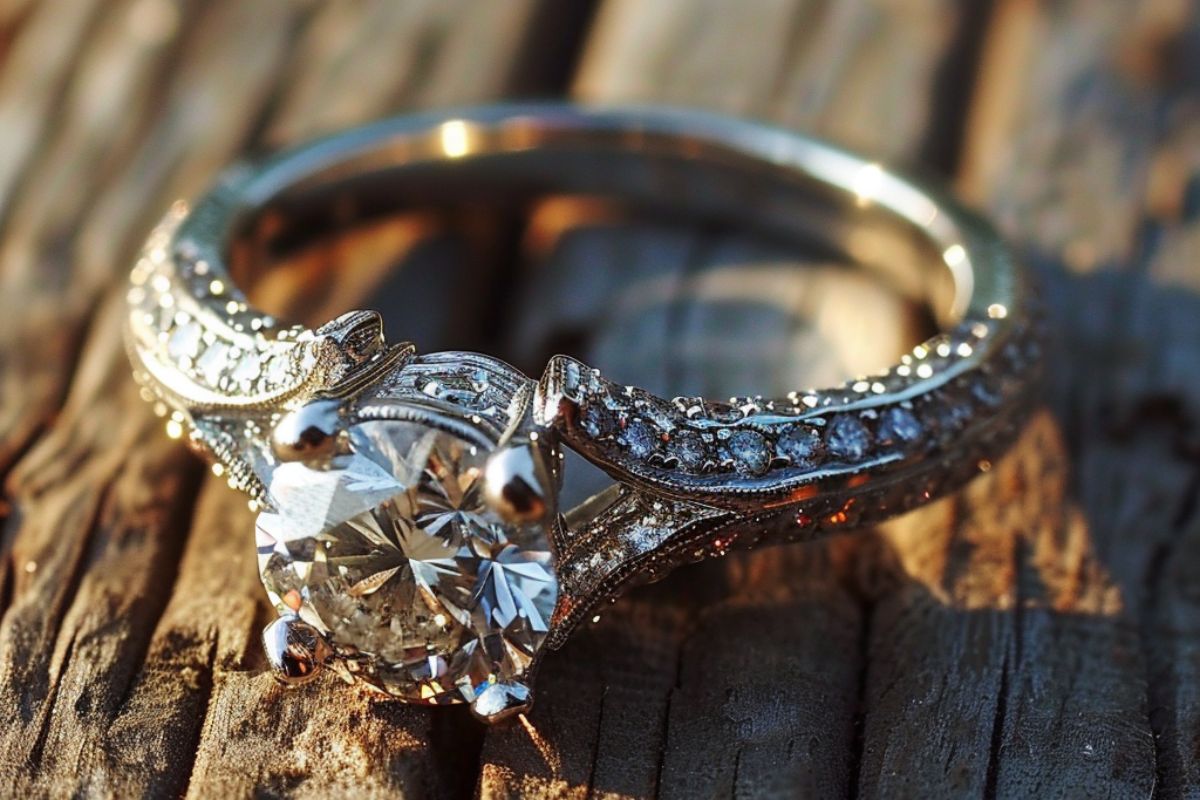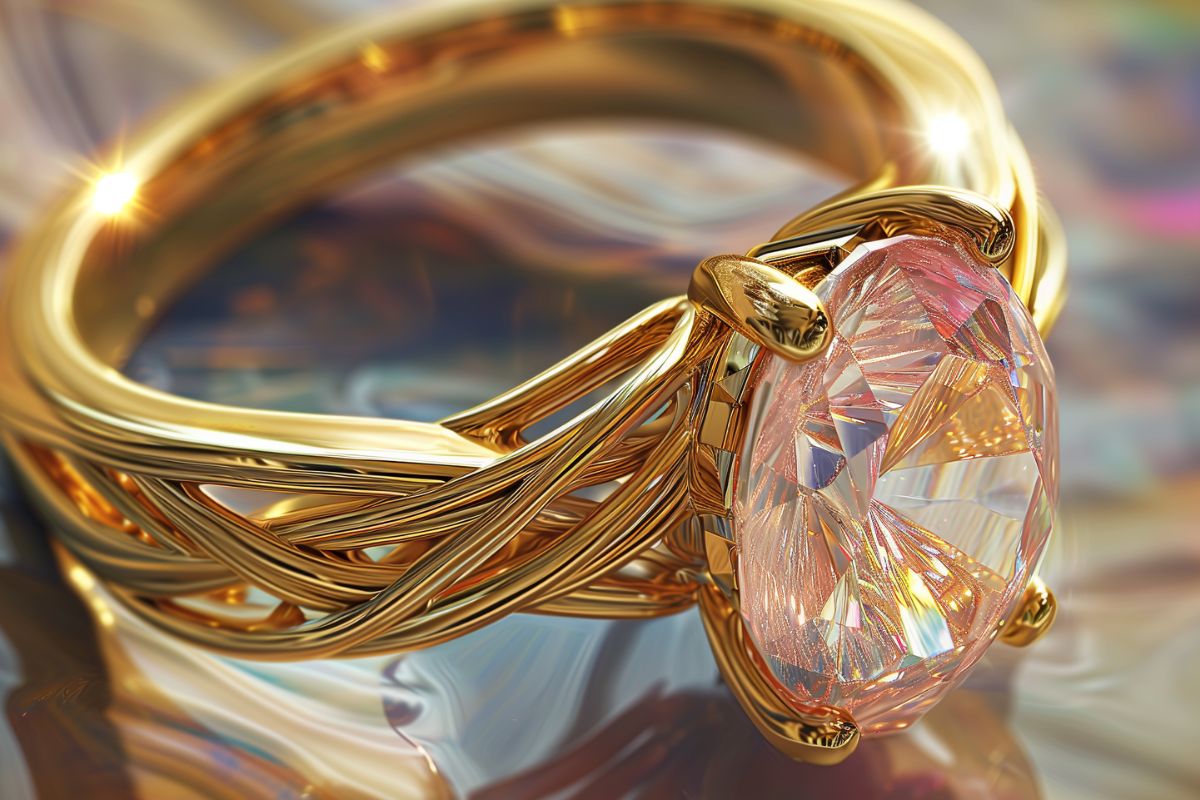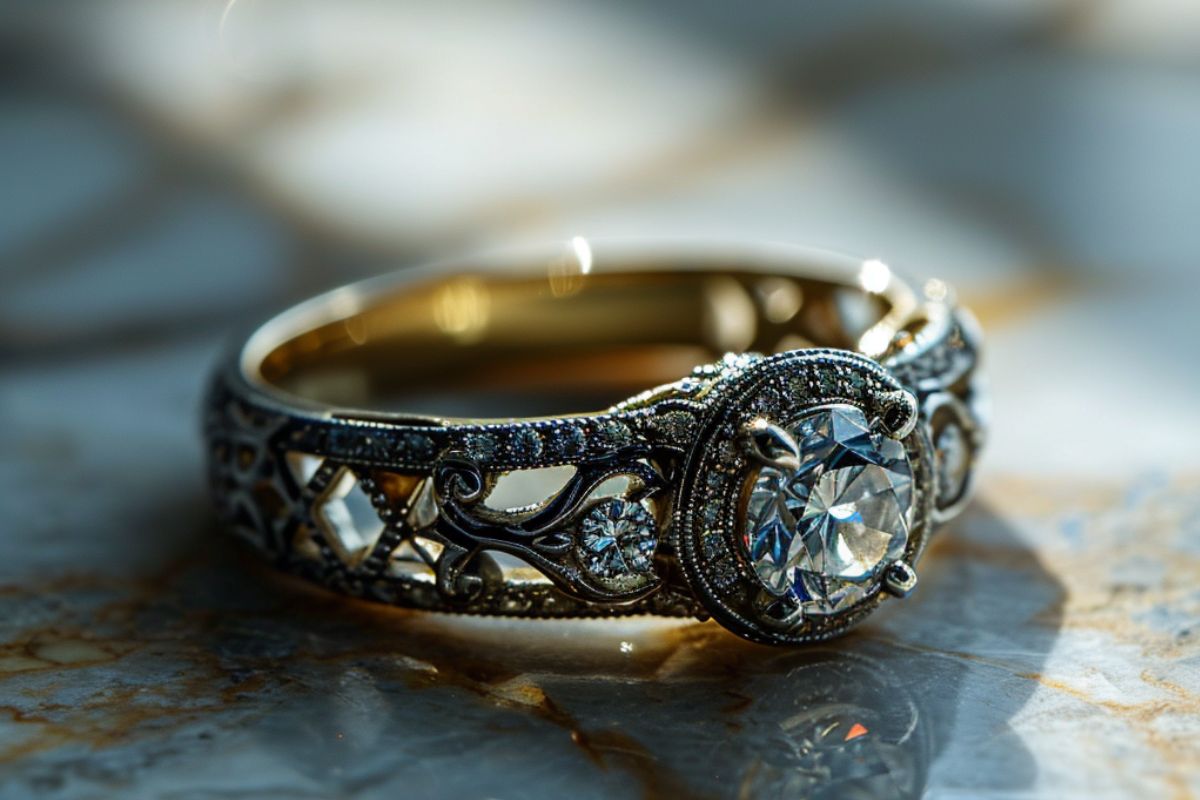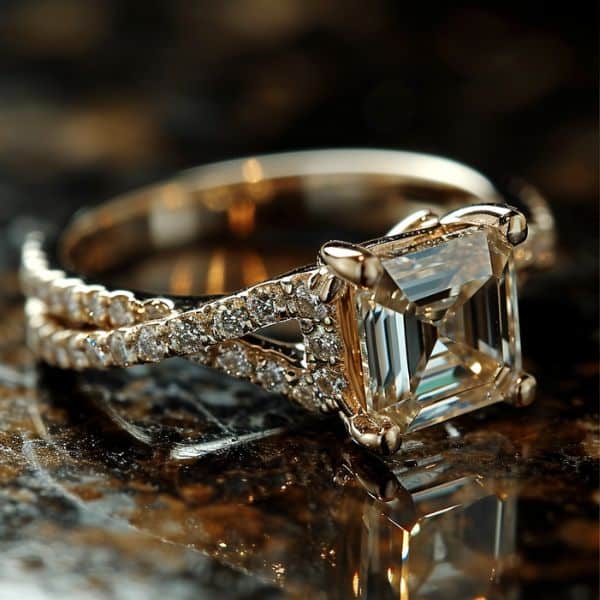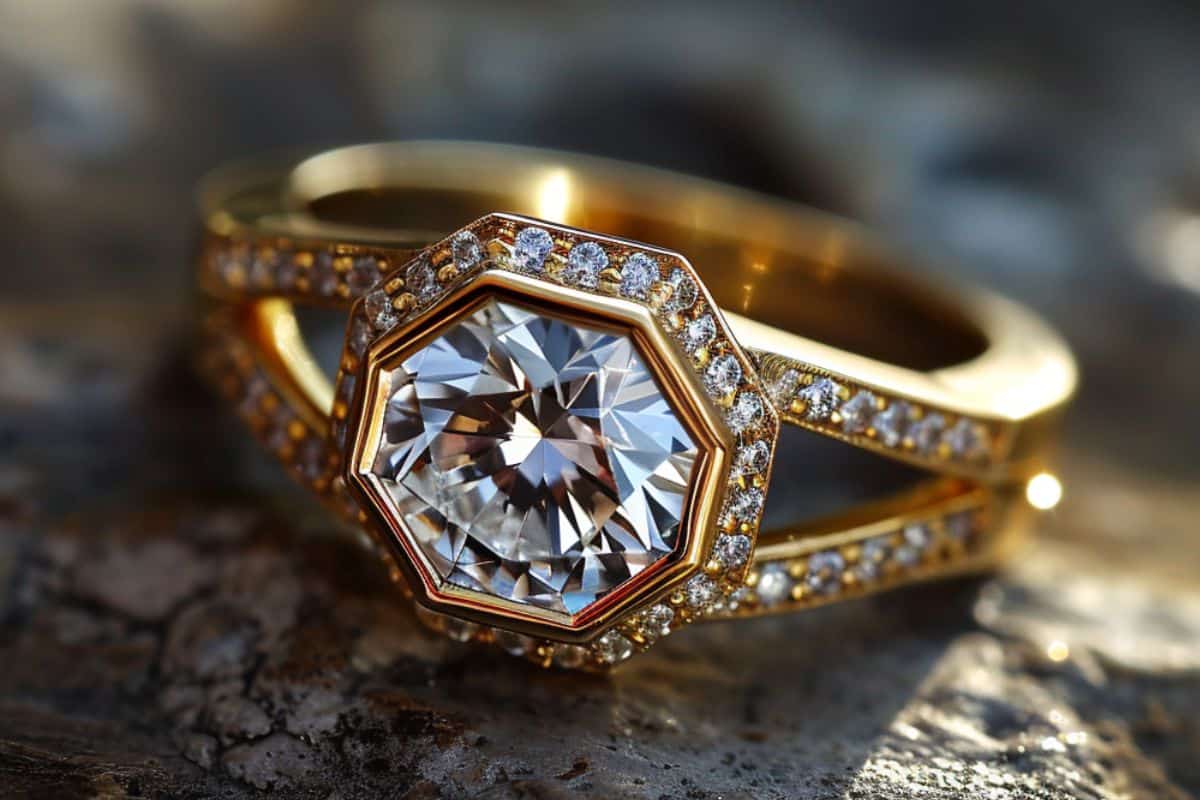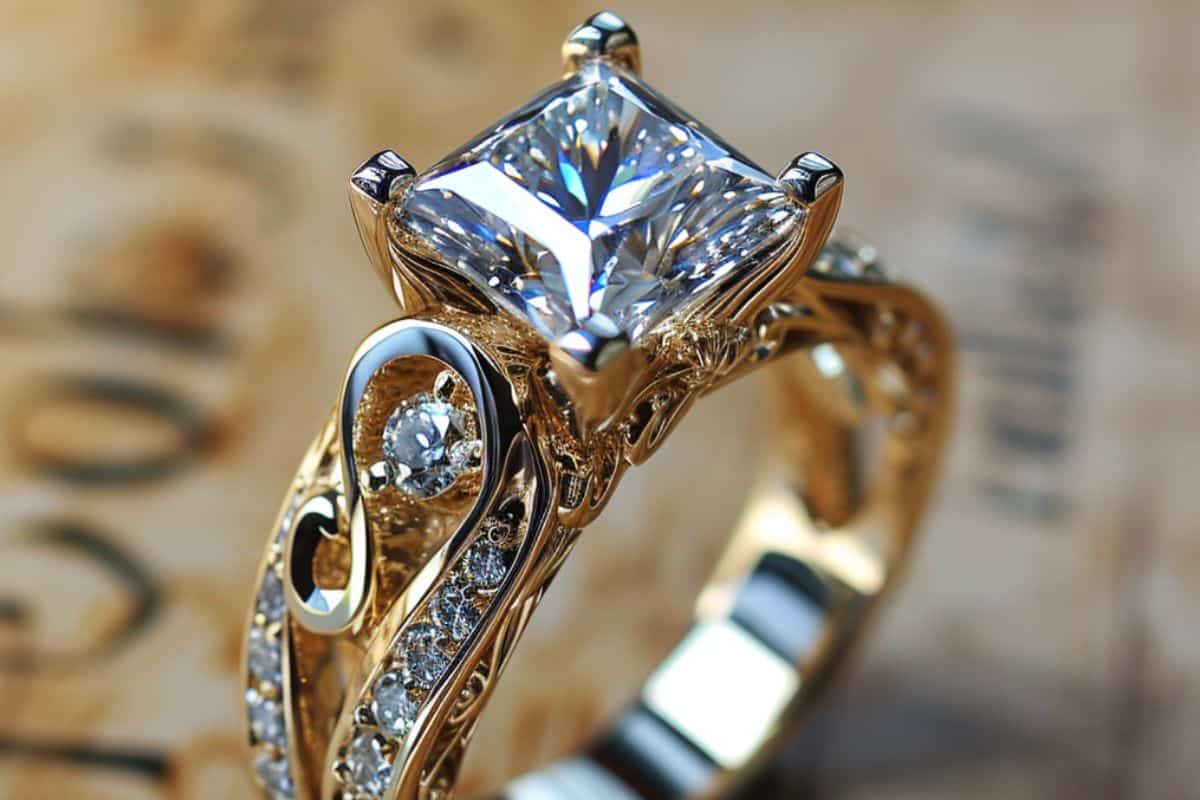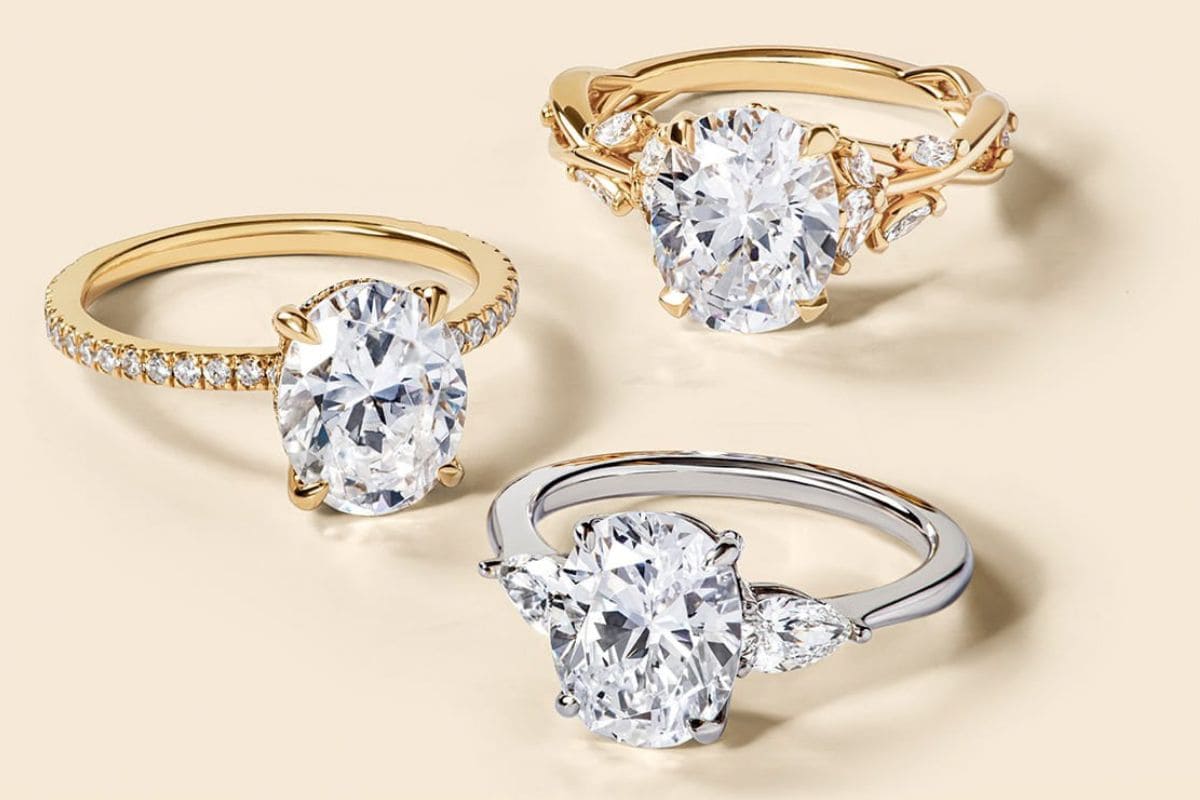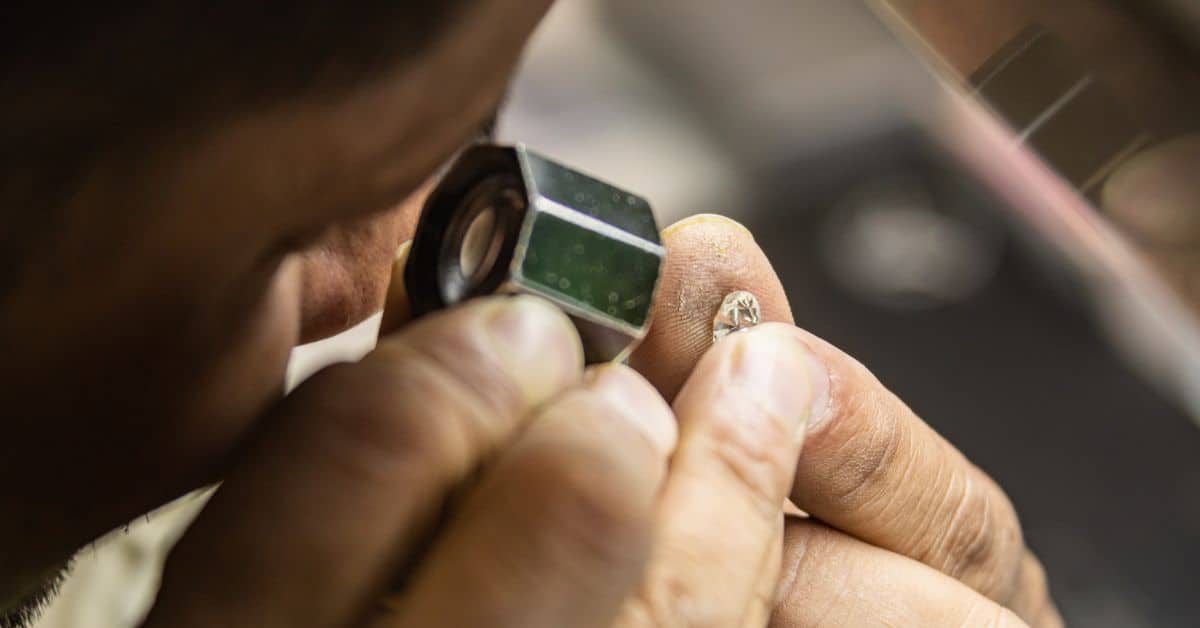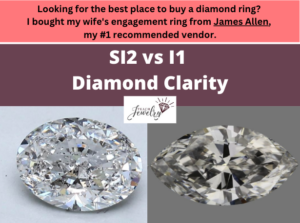
Diamond clarity refers to the presence of inclusions. These flaws develop during the diamond’s formation and affect its durability, visible appearance, and brilliance.
Clarity grades range from flawless, where no inclusions are visible with 10x magnification, to I3, which means it’s heavily included.
It’s not always easy to identify the differences between SI2 and I1 diamonds because there are significant inclusions in both.
So we’ll compare SI2 versus I1 diamond clarity, including an overview of both grades, how they’re different, and how you should decide which diamond is right for you.
What is an SI2 Diamond?
An SI2 (slightly included) diamond is a clarity grade given to a diamond that often features several types of inclusions.
It’s one grade below SI1 on the GIA clarity scale, which indicates its inclusions are more visible and impactful than ones that receive the higher grade.

To see a real example, check out this detailed image of an SI2 diamond from the vendor where I bought my wife’s engagement ring.
It’s often difficult to distinguish between a single clarity grade with the naked eye, but the SI2 diamond would have slightly darker or larger inclusions or ones that have more of an effect on its overall structure.
For example, it may have a white twinning wisp inclusion on the side of its table. There could be a few black spots scattered throughout the diamond caused by dark crystals growing inside.
When viewed from the top-down, these inclusions aren’t always noticeable. Instead, inclusions in SI2 diamonds are often visible from the side.
Some buyers choose settings that disguise these areas because they’re more visible to others who see your ring. When a prong or bezel is placed on top of the inclusion, it disappears from view.
As long as the inclusions are minor, the prongs disguise ones in those positions.
What is an I1 Diamond?
I1 (included) clarity diamonds have significant inclusions in several places throughout the diamond. It’s the third lowest grade, above I3 clarity and I2.
They’re given a low grade because the inclusions have a major impact on its light performance, ability to withstand hits or drops, and visual appearance.
If you place an I1 diamond next to one higher on the GIA clarity scale such as VS2 or VS1, the differences are immediately apparent.
There could be a white feather extending across the table, pinpoint inclusions, and etch channels. Each of these affect a diamond in a different way.
In general, they have more of a negative effect if they’re large and near vulnerable areas such as a thin girdle.
While some inclusions can be hidden with the right setting, it can be difficult to cover all the inclusions in an I1 diamond. They may be so spread out that they can’t be covered by a bezel setting or prongs.
What are Differences Between SI2 Clarity and I1 Diamonds?
1. I1 Diamonds Have More Impactful Inclusions
Diamonds receive an I1 versus S12 clarity grade because the inclusions are either larger, darker, or a more severe type.
For example, the twinning wisp may be white in an SI2 diamond and only noticeable if you view it up close, but on an I1 diamond, it could have some color.
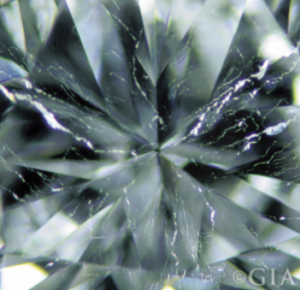
A colored twinning wisp often diminishes the appearance and brilliance of the diamond more than a white one, so it earns a lower clarity grade.
Or the I1 diamond could have a cavity that leaves it more vulnerable to chipping if dropped.
While both S12 and I1 diamonds can have cavities, the one in the I1 diamond is likely larger.
As a general rule, inclusions located near vulnerable areas are more impactful. You can view the position of each inclusion on the GIA report’s clarity characteristics plot.
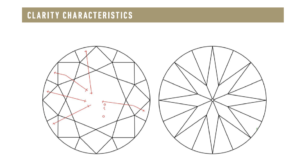
It’s located at the bottom of the middle panel and is accompanied by a key that identifies the symbols for each inclusion.
2. SI2 Diamonds Can be Eye-Clean
Many buyers are less concerned with a specific clarity grade than the actual appearance of the diamond to the naked eye. You don’t have to purchase a flawless diamond in order for it to be free of visible inclusions.
As an example, the image below is of an SI2 oval cut diamond.
Even in high-resolution, it’s inclusions aren’t visible. So it’s unlikely they could be seen when placed in a normal setting.
A diamond with inclusions that are only visible with magnification are called eye-clean diamonds.
SI2 diamonds can be eye-clean, but I1 diamonds rarely have this designation.
In fact, it’s recommended if you want a diamond without visible inclusions that you start with an SI1 clarity grade and go up from there.
Despite this general recommendation, there are instances where you can find an eye-clean SI2. If you’re searching for a diamond that’s one-carat or less, the inclusions may be too small to view.
If that’s the case, you can save money by choosing a diamond with a lower clarity grade or instead put that savings toward a higher carat weight or better color or cut.
But always view a high-quality image of an SI2 diamond before you buy it, so you know if it has any visible inclusions.
3. I1 Diamonds are Less Expensive
If all other qualities are equal, I1 diamonds are less expensive than SI2 diamonds because of the lower clarity grade.
A lack of inclusions is a valuable trait in a diamond, so if there are more flaws, it will sell for a lower price.
To give an example, I compiled prices from online diamond retailer James Allen for diamonds that have all the same qualities, except some are graded I1 and others are SI2. They earned the following grades:
- Carat: 1.00
- Cut: Very good
- Color: D
For an I1 diamond with these qualities, the average price is $3,781, with a range of $3,270-$4,710.
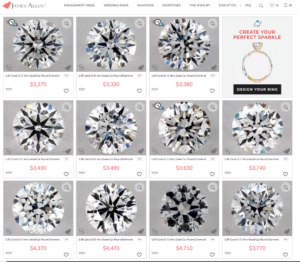
For an SI2 diamond, the average is $4,476, and the range is $3,190-$6,670.
That’s an 18 percent premium for an SI2 diamond versus an I1 diamond.
This same principle applies as you move up the clarity scale. Diamonds with fewer and less impactful inclusions usually sell for higher prices when all other qualities are equal.
You can expect the price of diamonds to increase 10-20 percent for every step up the clarity scale. It’s on the higher end when you move from one category to the next, like SI to VS or VS to VVS.
Those premiums aren’t worth it if you can’t tell the difference between the two diamonds, but if one is eye-clean and the other isn’t, it’s still a strong value to pay the higher price.
4. SI2 Diamonds are More Durable
Inclusions affect the structure of a diamond and make it susceptible to chipping. The extent to which this problem occurs depends on the size, location, and type of inclusion.
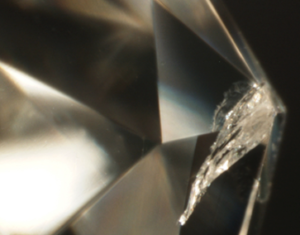
For example, small pinpoints in an SI2 diamond are unlikely to cause a chip. They’re present in almost every SI diamond but are often invisible.
On the other hand, indented naturals are often found near the girdle and dip below the polished surface.
If it’s large enough in an I1 diamond, it impacts durability in a similar way as a chip or cavity.
If it’s hit or struck against a surface, the indented natural could expand.
If you choose an I1 diamond, ensure it’s protected with a strong setting. For example, opt for a six-prong or bezel setting, which both offer more protection than a four-setting.
5. SI2 Diamonds are Fit for Engagement Rings
If you’re looking for an engagement ring diamond on the lower end of the clarity scale, choose SI2 versus I1.
The center diamond should have brilliance and appeal to the eye. Inclusions diminish both of those features.
You don’t want feathers, twinning wisps, etch channels, or indented naturals visible when showing off your diamond ring.
It might require choosing a higher clarity than SI2, but you can start there. In fact, most buyers choose a clarity grade higher than SI2 for their engagement ring diamond.
For small diamond accents or side stones, they often aren’t graded by the GIA or other organizations. That means there’s no official clarity grade.
But in some cases, they’ll have SI2, SI1, or VS2 grades attached.
In those cases, choose a setting where the diamonds have no visible inclusions, but it still adds brilliance to the piece.
Is an I1 or SI2 Diamond Right For Your Ring?
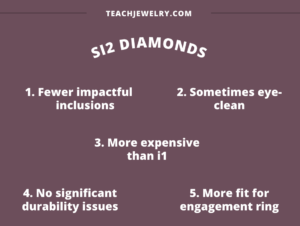
Choosing between an I1 and SI2 diamond involves understanding which qualities are most important to you.
Clarity is only one of the four Cs, so you should also consider carat, cut, and color. You may decide you’re willing to sacrifice clarity for a larger diamond, or you prefer a colorless diamond to one that lacks inclusions.
When it comes to deciding between I1 and SI2 clarity, here are some tips to consider.
You should choose an I1 diamond if:
- It’s a small diamond that won’t be the center diamond in an engagement ring
- You’re looking for a less expensive diamond
- You’ll protect it with a strong setting
You should opt for an S12 diamond if:
- You understand it may have inclusions visible from the side
- It’s an engagement ring diamond that weighs less than one carat
- You want a diamond that isn’t as vulnerable to chipping because of inclusions
Explore both I1 and SI2 diamonds at online and in-person vendors.
Once you’ve chosen your diamond, you can pair it with a setting to create the right ring or piece of jewelry for you.

Jacob Clarke
Jacob Clarke is the founder of TeachJewelry.com.
He earned an Applied Jewelry Professional Diploma from the Gemological Institute of America (GIA) and now brings you essential information about diamonds, settings, and more.
Jacob has consulted with leading jewelry brands, and his work has been cited in Clean Origin, Diamond Nexus and industry publications.
He's also a member of the International Gem Society.
He enjoys discussing jewelry with readers, so contact him with any questions at jacob.clarke@teachjewelry.com.

